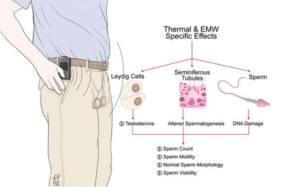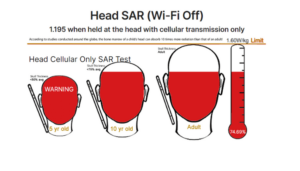The rapid rise of wireless technology has surely revolutionized how we communicate and live. But as convenient as it is, evidence is coming out showing that there are some risks we may be overlooking – particularly to children’s developing brains and men’s reproductive health. Research from a 2019 study in Frontiers in Public Health reveals that children absorb far greater doses of radio-frequency radiation (RFR) than adults, and men’s exposure to RFR is linked to significant declines in sperm quality. This blog takes a look at these specific concerns and what can be done to mitigate them.
RFR and Children’s Developing Brains
Children’s unique physiology makes them especially vulnerable to the effects of RFR. Studies highlight alarming facts:
- Deeper Radiation Penetration: A child’s thinner skull and higher water content allow RFR to penetrate deeper into their brain structures. Compared to an adult male, children’s bone marrow absorbs up to 10 times more radiation from cell phones held near their heads.

- Developmental Risks: Prolonged exposure to RFR during key developmental stages can result in cognitive delays, memory impairments, and behavioral problems. These outcomes are linked to DNA damage and oxidative stress caused by radiation.
- Increased Usage Equals Higher Risks: With children adopting wireless technology at younger ages and for longer durations, the cumulative risks are compounding over time.
The unique vulnerabilities of children make it crucial for parents, schools, and policymakers to prioritize reducing their exposure.
RFR and Male Fertility
Men’s reproductive health is another critical area impacted by RFR exposure. Here’s what the research reveals:
- Sperm Quality Declines: Men who habitually carry cell phones in their trouser pockets have significantly lower sperm counts and impaired sperm motility. Radiation exposure also leads to abnormal sperm morphology and mitochondrial DNA damage, which can contribute to infertility.
- Oxidative Stress: RFR induces oxidative stress in testicular cells, impairing their function and reducing sperm viability.
- Hormonal Disruption: Emerging evidence suggests that RFR may alter the hormonal balance necessary for reproductive health, further compounding the risks.

For men, particularly those planning to start families, taking steps to limit RFR exposure is essential.
Practical Ways to Reduce RFR Exposure
While it’s impossible to avoid RFR entirely in today’s world, there are effective ways to minimize its impact, especially for children and men.
For Children:
- Set Boundaries for Screen Time: Encourage children to engage in offline activities and limit their device usage.
- Create RFR-Free Zones: Keep devices like routers and tablets out of children’s bedrooms and play areas.
- Use Safer Communication Methods: Equip older children with wired headphones or encourage the use of speakerphone modes.
- Advocate for Safer Schools: Push for policies that favor wired internet connections over Wi-Fi in educational settings.
For Adults:
- Avoid Carrying Phones in Pockets: Use bags or holsters instead of keeping phones near your body.
- Reduce Call Duration: Use speaker mode or wired headphones for calls.
- Turn Off Unnecessary Features: Turn off Bluetooth, Wi-Fi, and location services when not in use to limit radiation emissions.
- Invest in Radiation-Blocking Accessories: Use specialized cases or pads to shield sensitive areas from RFR.
Advanced Tech Solutions

Products like those from Aires Tech are designed to neutralize electromagnetic radiation, creating a safer environment for families. These devices are portable, easy to use, and effective in reducing overall exposure.
Broader Implications for Society
The risks posed by RFR extend beyond individual health and touch upon societal well-being and environmental sustainability. Schools, workplaces, and public spaces are increasingly relying on wireless technology, steadily building exposure levels throughout our communities. Policies need to consider these more vulnerable populations, like children and aspiring parents, ensuring that safety standards evolve alongside technological advancements.
It’s also worth mentioning that the environmental impact of RFR should not be ignored. Studies are suggesting that prolonged electromagnetic exposure can harm pollinators like bees, disrupt ecosystems, and in turn potentially affect plant growth. Addressing these broader issues requires a holistic approach that prioritizes health and sustainability.
Policy Moves for Long-Term Safety
Individual actions are important, but systemic changes are vital to address these broader RFR risks. Policymakers and public health officials should:
- Update Safety Guidelines: Revise exposure limits to reflect non-thermal effects of RFR.
- Promote Public Awareness: Educate communities on RFR risks and mitigation strategies.
- Regulate Wireless Technologies: Implement measures to limit RFR exposure in public spaces, particularly schools and residential areas.
- Fund Research: Support long-term studies on RFR’s effects, especially with emerging technologies like 5G.
By encouraging and advocating for collaboration between governments, scientists, and industry leaders, we can create policies that balance technological progress with public health priorities.
In Conclusion
The evidence is pretty clear: RFR poses some significant risks to children’s developing brains and men’s reproductive health. Addressing these concerns requires a combination of personal precautions and broader societal action.
By implementing practical changes, leveraging innovative tools like Aires Tech products, and advocating for stricter safety standards, we can reduce RFR exposure and safeguard our health and that of future generations. Let’s take these steps today to ensure a healthier tomorrow.
With collective effort, we can build a world where technology enhances our lives without compromising our well-being or the environment.









